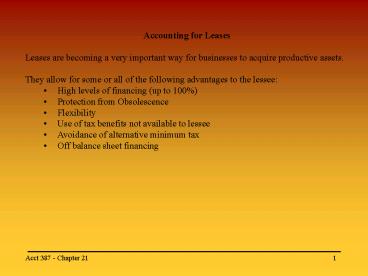Accounting for Leases - PowerPoint PPT Presentation
1 / 10
Title: Accounting for Leases
1
- Accounting for Leases
- Leases are becoming a very important way for
businesses to acquire productive assets. - They allow for some or all of the following
advantages to the lessee - High levels of financing (up to 100)
- Protection from Obsolescence
- Flexibility
- Use of tax benefits not available to lessee
- Avoidance of alternative minimum tax
- Off balance sheet financing
2
Accounting Issue The primary issue for
accountants is when, if at all, to bring the
lease on to the balance sheet. The profession
has determined that when the risks and rewards of
ownership are transferred, the lease should be
treated as a purchase. Lease payments are shown
as an obligation for lessee at their present
value, and the asset is shown as leased
property The lessor removes the asset from its
balance, recognizes a receivable, and may
recognize profit from selling the
asset. Generally the accounting is symmetric
3
- Capitalization Criteria
- Lessee capitalizes lease if one of the following
four conditions are met - Ownership transfers to lessee at end of lease
- The lease contains a bargain purchase option
- The life of the lease is 75 or more of life of
asset - The present value of the minimum lease payments
are 90or more of the fair value of the asset - Lessor must also meet BOTH OF the following 2
criteria - Collectibility of payments is reasonable
predictable - No important uncertainties surround the amount of
unreimbursable costs yet to be incurred by the
lessor (substantial performance)
4
- Important Terms
- Minimum Lease Payments
- Guaranteed vs. Unguaranteed residual
- Executory Costs
- Direct Financing Lease
- Sales Type Lease
- Operation lease
- Net investment in the lease
5
Lessee Accounting Leases are capital or
operating, based on capitalization criteria. For
capital leases, capitalize the present value of
the minimum lease payments (do not include
ungauranted residual) as leased asset and lease
obligation, depreciate asset, and amortize
obligation. At end of lease, either remove if
returned, or convert to owned asset.
6
- Direct Financing Lease
- Have if cost to lessor equals market value of
property - Lessor books
- Lease receivable for the present value of the
lease payments plus the residual (whether
guaranteed or not) - Removes the asset leased from its balance sheet
- Apportion each payment between interest and
principal. Net out the residual against the
lease payments receivable at end of life, can
have a gain or loss on ungauranted residual.
7
- Sales-Type Lease
- Have if cost to lessor is less than market value
of property - Lessor books
- Lease receivable for the present value of the
minimum lease payments plus the PV of the
unguaranteed residual - Sales for the present value of the minimum lease
payments (does not include ungauranted residual) - Credits inventory for the cost of the asset
- Debits cost of goods sold for the cost of the
inventory less the unguaranteed residual - Amortize the receivable to interest revenue
- May have gain/loss on ungauranted residual at end
of lease.
8
Residuals by Lessee
- Unguaranteed is ignored by lessee as they just
give the property back and have no obligation - Guaranteed is included in asset and the
obligation by lessee - Lessee can have a gain or loss at the end of the
lease depending on the fair value at the end of
lease versus the guaranteed residual
9
Residuals and Direct Financing
- Accounting is the same whether the residual is
guaranteed or not since the lessor gets it back
and is bearing the risk of its value - Lessor can have a gain or loss at the end if the
residual is not guaranteed.
10
Sales Type and Residual
- Guaranteed residual is included in the sale and
the cost of goods sold - Unguaranteed is included in the receivable and
the full cost of asset is removed from inventory - Cost of goods sold and sales are reduced by the
PV of the unguaranteed residual, thus treating
that part of the asset as essentially not being
sold































